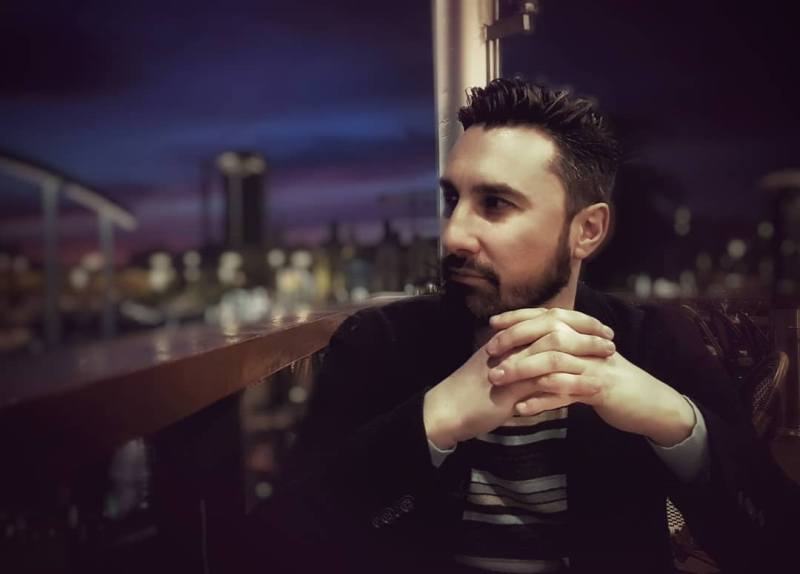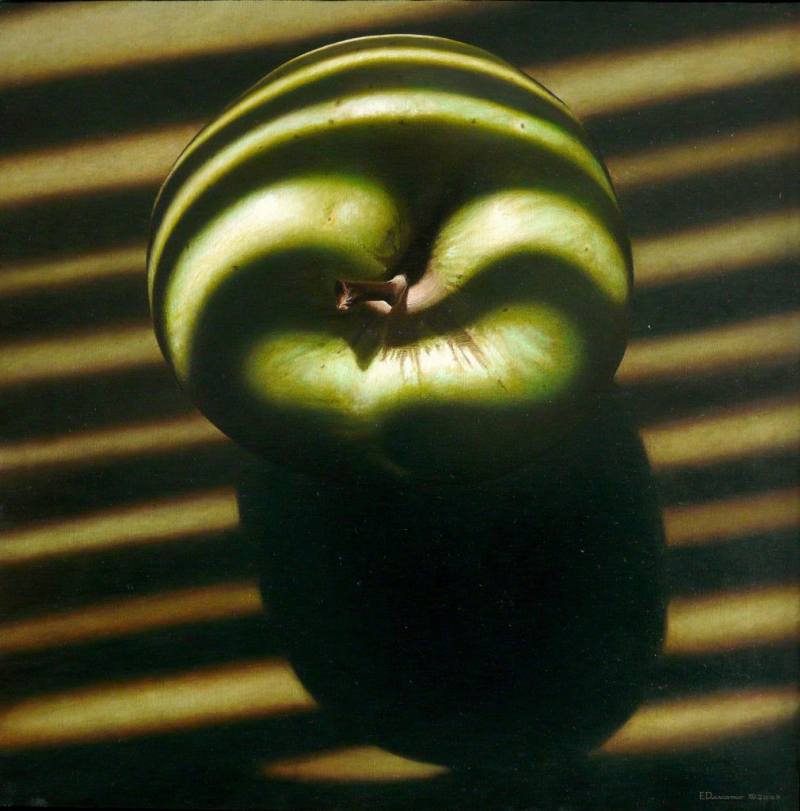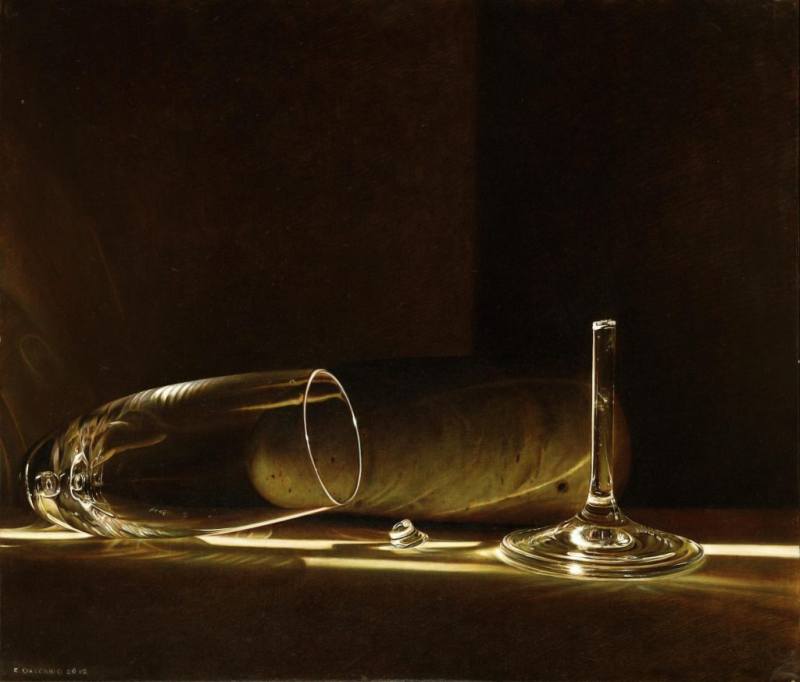Emanuele Dascanio
(Garbagnate Milanese, Italia / Italy, 1983-)
en Belgrado / at Belgrade, Serbia
Emanuele Dascanio
Emanuele Dascanio es un artista italiano nacido en 1983 en Garbagnate Milanese.
Después de graduarse en la Escuela de Arte Lucio Fontana de Arese, en 2003 se matriculó en la Academia de Brera, pero la abandonó después de seis meses.
Continuando con el deseo y la necesidad de crecimiento artístico, en 2007 estudió y trabajó en el atelier de Gianluca Corona, alumno del Maestro Mario Donizetti, encontrando en él un buen maestro y aprendiendo la técnica de la pintura al óleo tal y como se ha transmitido desde el Renacimiento.
Ha participado en varios concursos y exposiciones nacionales e internacionales, rankeado en los más altos puestos.
"O Fortuna (Oh fortuna / Oh Fortune)", carboncillo y grafito sobre papel /
charcoal and graphite on paper, 35 x 47 cm., 2013
"Depositio Maddalenae", carboncillo y grafito sobre papel /
charcoal and graphite on paper, 144 x 100 cm., 2015
Con una exquisita técnica, Emanuele crea impresionantes obras hiperrealistas para las cuales puede emplear más de 700 horas de minucioso trabajo, dibujando o pintando durante 12 horas diarias.
«El hiperrealismo es adecuado para mi poética porque estoy convencido de que un artista, además de saber pensar, también debe ser capaz de hacer.
En el tecnicismo extremo se esconde el trabajo del hombre, pero al mismo tiempo, en el tecnicismo extremo se revela el trabajo del hombre. En esta vibración de la contradicción se expresa lo sublime.»
"Vida y muerte / Life and Death", óleo sobre panel / oil on board, 50 x 50 cm., 2012
Colección privada / Private Collection
"Libertas?", carboncillo y grafito sobre papel /
charcoal and graphite on paper, 78 x 70 cm., 2014
«Siempre respiré el aroma del arte en mi familia. Siempre. Mi padre dibujaba bien. Mi madre era de Florencia y le gustaba la pintura. Solíamos visitar la galería Uffizzi. Mis abuelos me dejaron libros sobre Leonardo, dibujos, Rafael, Miguel Ángel, Caravaggio. Solía dibujarlos yo mismo. No cualquier niño tiene ese tipo de experiencia. Yo la tuve.»
"Uróboros / Ouroboros", carboncillo y grafito sobre papel /
charcoal and graphite on paper, 70 x 70 cm., 2019
Este exquisito y detallado dibujo de grafito y carboncillo representa a Uróboros de una manera inusual. Uróboros, en muchas culturas imaginada como una serpiente (del mundo) mordiéndose la cola y devorándose a sí misma, es de hecho un antiguo concepto filosófico que describe la circularidad de la vida y la historia humana. Simboliza la unidad, la totalidad, el infinito, el tiempo cíclico, la inmortalidad y la perfección.
Para Emanuele, el movimiento es la característica clave de Uróboros, ya que el universo consiste en eventos, no en objetos. Por ello el cabello que fluye hacia arriba y la vitalidad general de la obra. La mano del pasado a la izquierda casi toca la mano del futuro a la derecha, mientras que el presente nos mira fijamente a la cara. Una misteriosa cuarta figura permanece oculta a la vista pero está poderosamente presente. Esta obra está cargada de simbología y referencias filosóficas, que progresivamente se revelan en la medida en que la visión del espectador crece.
"Uróboros / Ouroboros" (detalle / detail)
This exquisitely detailed graphite and charcoal drawing depicts Ouroboros in an unusual way. Ouroboros, in many cultures envisioned as a (world) serpent biting its own tail and devouring itself, is in fact an ancient philosophical concept describing the circularity of life and human history. It symbolizes unity, wholeness, infinity, cyclical time, immortality and perfection.
To Emanuele, movement is the key characteristic of Ouroboros, as the universe consists of events, not objects. Hence, the upward flowing hair and the overall vibrancy in the work. Past’s hand on the left nearly touches Future’s hand on the right, while Present stares us squarely in the face. A mysterious fourth figure remains hidden from view yet is powerfully present. This work is laden with symbology and philosophical references, that progressively reveal themselves to the extent that the viewer’s insights grow.
"Oltre / Más allá / Beyond", óleo sobre lienzo / oil on canvas, 50 x 50 cm., 2009
«No puedo explicar el significado de cada imagen, pero puedo dar la clave de la interpretación correcta. En mis naturalezas muertas intento incorporar un fuerte significado simbólico, porque en realidad hay un poderoso vínculo que lo une todo. Siempre estamos en constante condicionamiento del espíritu y la materia. Lo que quiero decir es que a través de la lectura de las pequeñas cosas podemos entender las más grandes; ya sean psicológicas, físicas, espirituales y así sucesivamente. La naturaleza es un libro siempre abierto. El misterio es verdaderamente tal si se revela a nuestros ojos lentamente.»
"Alef - Beit", carboncillo y grafito sobre papel /
charcoal and graphite on paper, 100 x 100 cm., 2016. Modelo / Model: Monica Orsini
"Estudio para la cabeza de Santa Ágata / Study for St. Agatha's Head"
Carboncillo y grafito sobre papel / charcoal and graphite on paper, 20 x 20 cm., 2015
«Usar grandes fotos es como usar un mapa, pero si es posible prefiero hacer estudios del natural. Lo que me interesa es que ninguno de los dos puede existir sin la luz. Sin la luz no habría sujeto, y la luz tiene la capacidad de cambiar la percepción que tenemos de esta materia. La luz tiene la capacidad de contar historias, de mentir o de decir la verdad.»
"Abel", óleo sobre panel / oil on board, 40 x 35 cm., 2012
"El Padre no quiere divorciarse de La Madre. Este es mi padre /
The Father does not want a divorce with Die Mutter. This is my Father"
Carboncillo y grafito sobre papel / charcoal and graphite on paper, 80 × 65 cm., 2013
Emanuele no cree que haya una conexión estilística voluntaria con la obra de Caravaggio.
«Quizás inconscientemente me inclino más a preferir este "invento" de Caravaggio, esta luz teatral que caracteriza, dramatiza y narra los temas, por el sentimiento que tengo con la humanización de la realidad. Yo también amo y necesito mostrar "todo", el todo, a través del énfasis en lo particular. Concebir lo espiritual a través de lo carnal, tal vez lo consigas sólo a través de una perspectiva única.»
"El padre... (detalle) / The Father... (detail)"
Emanuele trabajando en "El Padre..." / working in "The Father..." ver video / see video
Emanuele Dascanio is an Italian artist born in 1983 in Garbagnate Milanese.
After graduating from Lucio Fontana Art School of Arese, in 2003 he enrolled at the Academy of Brera, but he abandoned the academy after six months.
Continuing to feel a desire and the need for artistic growth, in 2007 studied and worked in the atelier of Gianluca Corona, student of Master Mario Donizetti, finding in him a good teacher and learning the technique of oil painting as it has been handed down from the Renaissance.
He has participated in various competitions and exhibitions at national and international ranking near the top.
"Amplecti vitae (Disfruta la vida / Enjoy Life)"
Óleo sobre lienzo / oil on canvas, 160 x 110 cm., 2013. Colección privada / Private Collection
"La noche no existe / The Night Doesn’t Exist", carboncillo y grafito sobre papel /
charcoal and graphite on paper, 60 x 40 cm., 2017
With an exquisite technique, Emanuele creates impressive hyper-realistic works for which he can spend over 700 hours of painstaking work, drawing or painting for 12 hours a day.
"Hyperrealism is suitable for my poetics because I am convinced that an artist, besides knowing how to think, must also be able to do.
In the extreme technicality is hidden the work of man, but at the same time, in the extreme technicality is revealed the work of man. In this vibration of contradiction the sublime is expressed."
__________________________________________________________
"Estudio para la cabeza de un apóstol / Study For An Apostle’s Head"
Carboncillo y grafito sobre papel / charcoal and graphite on paper, 20 x 20 cm., 2015
«I was always breathe the art-scent in my family. Always. My father used to draw fine. My mother was from Florence and fond of painting. We used to visit the Uffizzi gallery. My grandparents donated me books about Leonardo, drawings, Raffaello, Michelangelo, Caravaggio. I used to draw them by myself. Not any child get that kind of experience. I did det it.»
"Sanctum", óleo sobre panel / oil on board, 50 x 50 cm., 2012
Colección privada / Private Collection
"Alegoría de lo sublime / Allegory Of The Sublime"
Carboncillo y grafito sobre papel / charcoal and graphite on paper, 69,5 × 49 cm., 2013
«Una imagen, para ser veraz, debe representar algo más allá de lo que los ojos pueden ver.
Ella está sosteniendo algo que no puede verse, de hecho el verdadero sujeto no está dibujado, está oculto por el pulgar. ¡Está oculto! Y ahí es donde está lo sublime.»
«An image, in order to be truthful, must portray something beyond what the eyes can see.
She's holding something that cannot be seen, in fact the real subject is not drawn, it's hidden by the thumb, it is hidden! And that's where the sublime lies.»
"Monica", carboncillo y grafito sobre papel / charcoal and graphite on paper, 30 x 25 cm., 2015
«Cuando dibujas la piel de una chica, además de la extrema dificultad, porque la creación es muy difícil, porque necesitas crear una piel suave, aterciopelada bajo una luz suave, sientes como si estuvieras haciendo el amor con ella. No en el sentido sexual. HACIENDO EL AMOR, ya que estás desarrollando algo duradero.»
«When you draw girl's skin, apart from the extreme difficulty, because creating is much more difficult, because you need to create a smooth, velvety skin in a soft light, you feel like you ar making love with her. Not in a sexual attitude. MAKE LOVE, as you are developing something durable.»
"Artemisia Gentileschi", carboncillo y grafito sobre papel, sobre lienzo /
charcoal and graphite on paper on canvas, 140 x 90 cm., 2016
Artemisia Gentileschi en "El Hurgador" / in this blog:
"La luna e le donne / La luna y las mujeres / The Moon And Women"
Óleo sobre panel / oil on board, 30 x 40 cm., 2009
«I cannot explain the meaning of each picture, but I can give the key to the correct interpretation. In my still life I aim to embed strong symbolic meaning , because in reality there is a powerful bond that binds everything. We are always in constant conditioning spirit and matter – what I mean is that through reading the small things we can understand the bigger ones; be they psychological, physical , spiritual and so on. Nature is an always-open book. Mystery is truly such if it is revealed to our eyes slowly.»
"Fortuna et Contingentiae (Fortuna y contingencia / Fortune And Contingency)"
Carboncillo y grafito sobre papel / charcoal and graphite on paper, 100 x 70 cm., 2016
«Using great photos is like using a map but if at all possible, I prefer to make studies from nature (life.) What’s interesting to me is that neither can exist without the light. Without light there would be no subject and the light has the ability to change the perception that we have of this matter. The light has the ability to tell stories, to lie or to tell the truth.»
"Rosa Rùtila", carboncillo y grafito sobre papel /
charcoal and graphite on paper, 90 × 65 cm., 2013
Emanuele does not believe that there is a voluntary stylistic connection with Caravaggio's work.
«Maybe unconsciously I am more inclined to prefer this "invention" by Caravaggio, this theatrical light that characterizes, dramatizes and narrates the subjects, for the feeling I have with the humanization of reality. I too love and need to show "everything", the whole, through the emphasis on the particular. Conceive the spiritual through the carnal, perhaps you get it only through a single perspective.»
"Rosa Rùtila" (detalle / detail)
Emanuele trabajando en / at work in "Rosa Rùtila"
"Detrás de 6 pinturas / Behind 6 Pictures"
_____________________________________________________________
Fuentes / Sources:
* Website
* "Emanuele Dascanio en exclusiva para toda Hispanoamérica y el mundo /
exclusively for all of Latin America and the world"
Entrevista en / Interview in Globedia, 12/2013
* "Emanuele Dascanio el gran Maestro del arte italiano / The Great Italian Master Artist"
Entrevista de / Interview by Cindy Wider, 2/2014. Parte 1 / Part One, Parte 2 / Part Two
* "L’iperrealismo pittorico di Emanuele Dascanio / El hiperrealismo pictórico de / Emanuele Dascanio
Emanuele Dascanio's pictorial hyperrealism"
Entrevista de / Interview by Alessandro Rossi, 9/2013. Organiconcrete
* "Detrás de 6 pinturas / Behind 6 Pictures"
Corto de / Short film by Emanuele Dascanio. Dirigido por / Directed by Luca Pischedda
Imágenes publicadas con autorización del artista (¡Muchas gracias, Emanuele!)
Images published here with artist's permission (Thanks a lot, Emanuele!)



























No hay comentarios:
Publicar un comentario